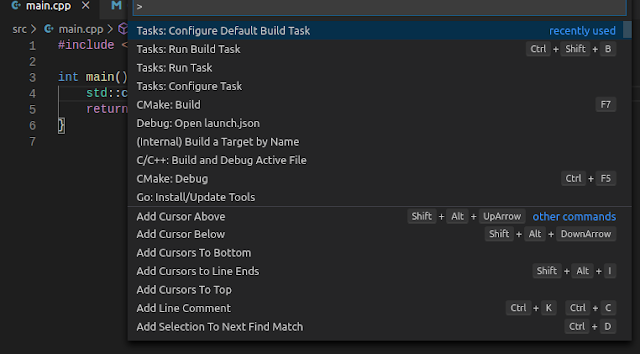Download Boost archive from Version 1.72.0 (that is the current version at the time of writing).
Go to the directory where you want to install Boost:
$ cd ~/dev
Unpack the downloaded archive (tar will create boost_1_72_0 directory):
$ tar --bzip2 -xf ~/Downloads/boost_1_72_0.tar.bz2
$ ls
boost_1_72_0 github gnome go ssh-keys vm vm-shared
Let's see the content of ~/dev/boost_1_72_0/:
~/dev/boost_1_72_0$ ls -A1
boost
boost-build.jam
boostcpp.jam
boost.css
boost.png
bootstrap.bat
bootstrap.sh
doc
index.htm
index.html
INSTALL
Jamroot
libs
LICENSE_1_0.txt
more
README.md
rst.css
status
tools
Let's see the content of ~/dev/boost_1_72_0/boost/:
~/dev/boost_1_72_0/boost$ ls -A1
accumulators
algorithm
align
aligned_storage.hpp
align.hpp
any.hpp
archive
array.hpp
asio
asio.hpp
assert.hpp
assign
assign.hpp
atomic
atomic.hpp
beast
beast.hpp
...
lambda
...
lambda
...
Many Boost libraries are header-only which means we don't need to build them, it is only necessary to add relevant header in the source code and path to it to compiler (-I) options.
Boost documentation page Getting Started on Unix Variants contains a short demo code and I'm gonna use it here. It uses boost/lambda/lambda.hpp header from so let's see the content of ~/dev/boost_1_72_0/boost/lambda/ to confirm it's there:
~/dev/boost_1_72_0/boost/lambda$ ls -A1
algorithm.hpp
bind.hpp
casts.hpp
closures.hpp
construct.hpp
control_structures.hpp
core.hpp
detail
exceptions.hpp
if.hpp
lambda.hpp
loops.hpp
numeric.hpp
switch.hpp
Let's create a project in VSCode with following structure:
.vscode/tasks.json
build/
src/main.cpp
.gitignore
CMakeLists.txt
.vscode/tasks.json:
{
// See https://go.microsoft.com/fwlink/?LinkId=733558
// for the documentation about the tasks.json format
"version": "2.0.0",
"tasks": [
{
"type": "shell",
"label": "CMake && make",
"options": {
"cwd": "${workspaceFolder}/build"
},
"command": "cmake make -DCMAKE_BUILD_TYPE=Debug .. && make -j 4",
"group": {
"kind": "build",
"isDefault": true
}
}
]
}
src/main.cpp:
#include <boost/lambda/lambda.hpp>
#include <iostream>
#include <iterator>
#include <algorithm>
int main() {
std::cout << "main()" << std::endl;
using namespace boost::lambda;
typedef std::istream_iterator<int> in;
std::for_each(in(std::cin), in(), std::cout << (_1 * 3) << " " );
return 0;
}
CMakeLists.txt:
cmake_minimum_required(VERSION 3.0)
project(boost-demo)
set(SOURCE src/main.cpp)
set(BOOST_ROOT "$HOME/dev/boost_1_72_0")
include_directories(include)
add_executable(${PROJECT_NAME} ${SOURCE})
Press CTRL+SHIFT+B in order to trigger building the project:
> Executing task: cmake make -DCMAKE_BUILD_TYPE=Debug .. && make -j 4 <
-- Configuring done
-- Generating done
-- Build files have been written to: /home/bojan/dev/github/boost-demo/build
Scanning dependencies of target boost-demo
[ 50%] Building CXX object CMakeFiles/boost-demo.dir/src/main.cpp.o
[100%] Linking CXX executable boost-demo
[100%] Built target boost-demo
Terminal will be reused by tasks, press any key to close it.
The output is an executable which we can run now:
~/dev/github/boost-demo$ ./build/boost-demo
main()
1
3 2
6 3
9 4
12 7
21 ^C
The example above shows how it's simple to include Boost headers in C++ CMake project.
For some Boost features, we need to compile and install certain Boost libraries.
How to compile and install Boost binaries?
~/dev/boost_1_72_0$ ./bootstrap.sh --help
`./bootstrap.sh' prepares Boost for building on a few kinds of systems.
Usage: ./bootstrap.sh [OPTION]...
Defaults for the options are specified in brackets.
Configuration:
-h, --help display this help and exit
--with-bjam=BJAM use existing Boost.Jam executable (bjam)
[automatically built]
--with-toolset=TOOLSET use specific Boost.Build toolset
[automatically detected]
--show-libraries show the set of libraries that require build
and installation steps (i.e., those libraries
that can be used with --with-libraries or
--without-libraries), then exit
--with-libraries=list build only a particular set of libraries,
describing using either a comma-separated list of
library names or "all"
[all]
--without-libraries=list build all libraries except the ones listed []
--with-icu enable Unicode/ICU support in Regex
[automatically detected]
--without-icu disable Unicode/ICU support in Regex
--with-icu=DIR specify the root of the ICU library installation
and enable Unicode/ICU support in Regex
[automatically detected]
--with-python=PYTHON specify the Python executable [python]
--with-python-root=DIR specify the root of the Python installation
[automatically detected]
--with-python-version=X.Y specify the Python version as X.Y
[automatically detected]
Installation directories:
--prefix=PREFIX install Boost into the given PREFIX
[/usr/local]
--exec-prefix=EPREFIX install Boost binaries into the given EPREFIX
[PREFIX]
More precise control over installation directories:
--libdir=DIR install libraries here [EPREFIX/lib]
--includedir=DIR install headers here [PREFIX/include]
To Be Continued...

